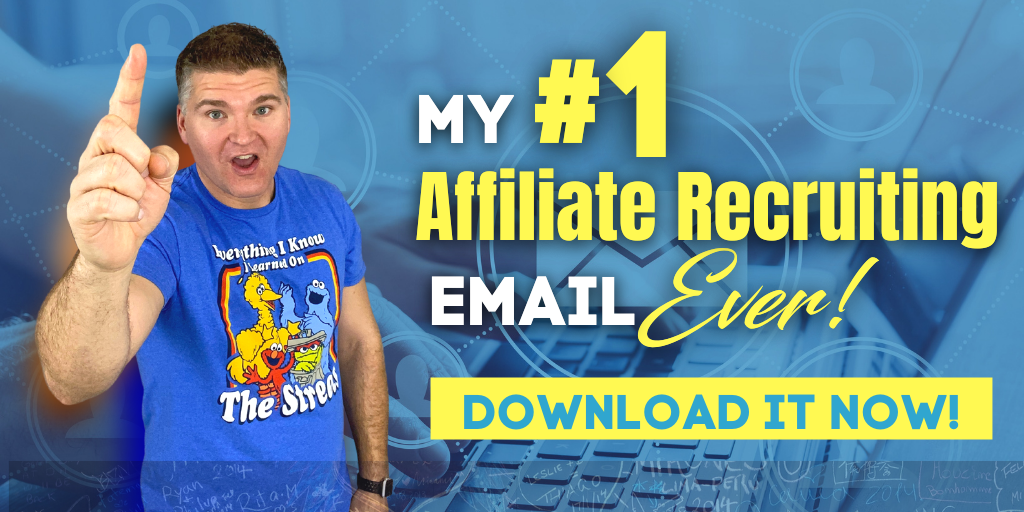Your affiliate program agreement is one of the most overlooked, but important parts of setting up an affiliate program. I’ve created affiliate terms and conditions for top affiliate programs like Shutterfly and Adidas and know what every affiliate program needs…and what to avoid. In this episode, I’ll show you how to create legally sound contracts for your affiliate program and I’ll share insider tips and real-world examples to guide you through the process. No need to be an attorney and you don’t even need to know how to speak legalese. I’ll break down the process into simple steps that anyone can follow.
Click Here for The Written Transcript of This Episode
Get the EXACT Template We Give to Our Affiliates to Get Them to Promote More and Generate More Sales! Click Here to Download it Now!
Links Mentioned in this Episode
Affiliate Terms & Conditions Template
What the 2023 FTC Updates Mean for Affiliate Marketing
How to Identify and Stop Affiliate Fraud
TEXT ME: 260-217-4619
Don’t Miss An Episode – Subscribe Below
Previous Episodes of The Affiliate Guy
What are the Legal Requirements for an Affiliate Program?
How to Build Great Relationships with Affiliates
How Do Affiliate Managers Spend Their Day?
How to Communicate Bad News to Your Affiliates
How to Triple Your Webinar Sales with Affiliates
How to Identify and Stop Affiliate Fraud
How to Create an Affiliate Program Agreement
Your affiliate program agreement is one of the most overlooked but important parts of setting up an affiliate program. I’ve created affiliate terms and conditions for top affiliate programs like Shutterfly and Adidas, and I know what every affiliate program needs and what to avoid. So in this episode, I’m going to show you how to create legally sound contracts for your affiliate program. I’m going to share some of my insider tips and some real world examples to guide you through the process. There’s no need to be an attorney. You don’t even know how to speak legalese. I’m going to break down the process into simple steps that anyone can follow.
Let’s get started. So I’m taking a risk here.
I’m going out on a limb and I’m doing back to back episodes on really boring topics. Last week was all about the legal requirements for affiliate programs. This week’s how to create an affiliate program agreement or terms and conditions. The terms are interchangeable there, right? So it’s a little bit of a risk. Like these are not exciting topics, but your terms and conditions, your agreement are. I’m going to just use the word agreement pretty much from this point forward.
But again, I’m going to use those terms interchangeably. So just bear with me. They mean the same thing. It’s super important because these set the stage for everything else. They set the stage for building trust, they set the stage for the rules. They set the stage for the guidelines that your affiliates have to follow, but also the things that you’re committing to.
They ensure that every affiliate is treated fairly. They ensure transparency. They know the rules. So when you have these rules, they should know the rules. If they break the rules, well, then they’ve broken the rules and we can, we’ll talk later about what to do in those situations. So if you’re just starting your affiliate program, do not put off creating your terms and conditions.
It is not just a formality, it is the foundation for your program’s success. So what I’m gonna do in this episode, I’m gonna guide you through the process of drafting your terms and conditions with clarity That’s the thing.
You have to understand what these things mean. Yeah, you could just say, hey, attorney, go create this. But your attorney is not an affiliate marketer. They are not running an affiliate program. And while it might be legally sound. It’s confusing and it actually costs you affiliates or it costs you So I’m going to walk you through these.
The process of this, as I’m doing, I’m going to share some real world examples, examples from affiliate agreements that we’ve written business down the road. over the years. Every solid contract, and this is a contract, has key components. So I’m going to walk you through each element. I’m going to explain what it is, why it’s crucial.
But first, as I did in the last episode, before we get into how to create your affiliate agreement, I have to say this. No, legally, I have to include this section here. Legal disclaimer I feel like I should hire a guy to read this right now.
A quick but essential note or he reads like super fast, right? While I’m providing this guidance here, it is no substitute for professional legal advice. I have to emphasize the content of this episode is intended to provide accurate and authoritative information. However, it should not be considered legal accounting or professional advice. If your affiliate program gets complex or you’re not entirely sure about the legal intricacies, you need to consult an attorney.
That’s a wise move. So I’m not a lawyer after all. I’m a podcaster right? Now. Again, I’ve created these, I’ve worked with attorneys. So it’s sound advice. As of the time of this recording, anything could change.
Need help activating your affiliates? Use my proven email templates for getting inactive affiliates in the game and making sales! Get them here!
The law could change from the time I hit record until this episode publishes a few weeks later. So just to be clear now, enough of the boring stuff, all right? If you do want to skip all the boring stuff, and I don’t think you should, I think you should understand why the suggestions that I make are what they are, I think you should understand some of the whys right behind this. But if you want to skip some of the boring stuff and just grab the template, I’ve got a free download.
You can actually download the template, the affiliate agreement template, and the link for that will be in the show notes. So just check the show notes. The link will be right there and you can grab that template. And I do walk through a little bit of what I’m saying today. I’m just going into more detail today, so you understand the different parts.
So let’s start at the very beginning. That’s a good place to start, as Mitch Hedberg would say, with the standard preamble. All right, so any terms and conditions should start with some sort of a preamble. I’m just going to read you an example here and then you’ll understand what I mean by that just says shutterfly affiliate program terms and conditions.
Please read our affiliate terms and conditions before you join our program or begin marketing our program. These terms and conditions are written in plain language, intentionally avoiding legalese to ensure that they may be clearly understood and followed by affiliates. Each affiliate is responsible for ensuring that its employees, agents, and contractors comply with these terms and conditions. Thank you.
Nothing fancy, right? It’s just a standard preamble. The next thing you need to do is definitions, right? You need to define any relevant terms. So this serves to make clear any of the ambiguous terms, right? Wherever you know, people might be like, wait, what does that mean? If you skipped to section eight, subsection b, what does that mean? We’ll go back up to the definitions, so it’s pretty boilerplate here.
Here’s an example from the definitions from the affiliate program for Michael Hyatt that we wrote as used in these terms and conditions. We, us or our refers to Michael Hyatt and Company incorporated and our website. You or your refers to the affiliate. And these are actually with like the little I, you know, all those little roman numerals, right? Our website refers to the Michael Hyde and Company Incorporated properties located at www. michaelhide come for your website refers to any websites that you will link to.
Our website five program refers to the Michael Hyde and company affiliated program. Again, just standard definitions, all boring boilerplate stuff, but also necessary so that no one questions what the definitions are. The next thing that we have is the approval and rejection policy.
Again, this is, we’re kind of going in chronological order from their interaction with the website, which is I’m applying, am I going to be approved or rejected and down through some other stuff that’ll happen later. And, and part of this is just setting expectations.
That’s the main part. Just setting the expectations. Part of it covers your b***. If you decline someone and they complain. I mean, it’s your affiliate program, you can make the rules, right? So they shouldn’t complain. Like they don’t really have a legal standing. But still, it’s good to cover this.
Again, part of this is like if you set the rules and you abide by them, they have nothing to complain about. So here’s an example that I often use with our clients. After receiving your application, we will review your website, notify you of your acceptance or rejection into our program.
Please allow up to 48 hours for your application to be reviewed. We reserve the right to reject any application. However, we encourage you to contact us if you feel we have made an incorrect decision, including all the websites that you use in your profile, will help us to make a better decision. So again, it sets the expectations, makes it clear that approving or declining affiliate is 100% up to the program itself.
Right. And the last part makes it clear they should include all their websites, which allows you to see the domains that they own. Again, we usually say 48. It should have said 48 business hours. I just didn’t read the word business there, 48 business hours. So that means if you apply on Friday at 05:00 p. m. you’re probably not going to hear from us, you know, get accepted until Monday. You can change it to 72 or whatever length of time you feel is necessary for your program.
The next thing is just basic rules for every affiliate program. You know, there are some rules that are specific. We’ll talk about this later. Certain types of affiliate programs, but there are some rules that apply to literally all affiliate programs. Whether you’re a retail establishment, you sell a digital product, high commission, low commission. These are the most basic universal rules that every affiliate program should enforce.
So you need to be clear about any website restrictions, linking techniques, black hat SEO practices, things like that. So if you’re not, like, if you are not clear about these, you could have a program full of, quote unquote undesirable affiliates, right? So the first is just website restrictions. Website restrictions here just sets the boundaries, right? This is about protecting your brand, protecting other affiliates.
So a lot of times what we’ll say is something like, you know, your participating website may not. Our website with parentheses ask may not number one, infringe on our or anyone else’s intellectual property, publicity, privacy or other rights. Number two, violate any law or regulation. Number three, contain any content that is threatening, harassing, defamatory, obscene, harmful to minors, contains nudity, pornography, or sexually explicit materials. Number four, contains any viruses, trojan horses, a bunch of other stuff. Again, you can copy these from the template.
If you go to link in the show notes, you can just copy these. That’s a long one there. Number five, contain software use technology that attempts to intercept, divert or redirect Internet traffic. Basically that, you know, cookie stealing, things like that, right? So see, these protect the integrity of the program, protect the integrity of your brand, and they make it clear in the rules there, it says if you violate these terms, we have the right to remove you. Obviously, you don’t want someone who is doing these things that they’re using.
Trojan horses, worms, cancel bots, things like that. They’ve got, you know, again, if you have a family friendly site. Again, if you don’t have a family friendly site, okay, that’s your choice. But most of the people we work with over the years would be considered family friendly.
They don’t want pornography. They don’t want, you know, harassing, threatening speech on sites. And so that’s going to harm the brand, it’s going to harm other affiliates.
Things like hate speech. Again, you can add or remove anything you like from that section, and you definitely do not want anything to do with sites that are using viruses or any. Those are nothing but trouble. I created a graphic like all affiliate programs should prohibit five things, right? Number one, spamming. Number two, viruses. Number three, trojan horses. Number four, cookie stuffing. Number five, illegal activity.
All of them. Everything else is subjective and up to you. But spamming viruses, trojan horses, cookie stuffing, and illegal activity, every program should prohibit those. The next thing you’ve got under this bigger agreement that you know, like the basic rules, right? It’s just rules for using links, what’s allowed and what’s not allowed when it comes to promoting your products or services.
These are not just about protecting your brand, but also we want to create a level playing field for all of our affiliates. Everybody knows the do’s and don’ts. So here’s an example. An affiliate agreement that we created for legacy learning systems years ago. Not going to read the whole thing, but says upon acceptance into the program, links will be made available to you through the affiliate interface.
Your acceptance into our program means you agreed to and abide by the following number one, you will only use linking code obtained from the affiliate interface without manipulation.
Number two, all domains that use your affiliate link must be listed in your affiliate profile. Number three, this is an important one. Your website will not in any way copy, resemble, or mirror the look and feel of our website. You will also not use any means to create the impression that your website is our website or any part of our website, including, without limitation, framing of our website in any manner.
So then we go on to say no cookie stuffing, no other illegal redirects, things like that. If you are found doing any of these things, or you attempt to hide or manipulate the original source of the link, your current and past commissions will be voided or your commission level will be set to 0%.
This does not include using out redirection, the same domain where the affiliate link is placed. So that doesn’t apply to pretty links and things like that. So when you look at these like just one by one, we’re preventing them from, you know, the number one where I say you only going to use the linking code, it prevents them from adding additional parameters that can mess up the tracking or steal the commission from another affiliate.
We actually often add at the end of the word manipulation. Usually we add unless you have obtained specific permission from the affiliate manager to manipulate the link for the purposes of ad tracking or other accepted methods of measuring link performance that makes it clear they can manipulate the links for tracking purposes as long as they have permission to do so.
Number two, all domains that use your affiliate link must be listed in your affiliate profile. Why is this? The biggest reason is it prevents affiliates from using domains that violate other parts of the agreement, such as the hate speech, pornography, obscene material, et cetera. But they’re not listed in their profile. So I go to their main site and it’s perfectly fine.
But they have five other domains. It also allows us to monitor all of their domains as a part of FTC compliance. And we talked about it last episode. If you have not yet, make sure you check out the guide that we put together on FTC compliance. You definitely want to check that out. It was a podcast episode I did a few months back, and you need to check that out to make sure you’re compliant with the FTC guidelines.
So the third one about copying the website, that’s a brand protector. I mean, the last thing you want is some rogue affiliate pretending they are you. All sorts of bad things can happen from that. Number four, we talked about, you know, no cookie stuffing, no pop ups, you know, no false or misleading links. That’s all about protecting your brand’s reputation and being fair to other affiliates if you’re not familiar with them.
Just real quick, cookie stuffing is basically where an affiliate places a tracking code on the user’s device without the user consenting to it or knowing it. So things like iframes and stuff like that, it’s extremely unethical. Extremely unethical. The whole point is to steal commissions. So instead of the correct affiliate getting the commission, the wrong one does, you know, pop ups. I don’t mean like where they can’t use a pop up on their site to collect email address.
I am talking about like run an automatic pop up of an affiliate link on their site. That is not allowed. That’s basically another way of cookie stuffing. URL masking is where they’re just masking the URL, so then they don’t know where, where are they? Basically it’s hiding referral sources and things like that. False links.
Basically, if the anchor text says free workout guide, but I land on a site for iPhone cases, that’s a false link. And so the thing about this section, it seems like, wow, there’s a lot of rules, and gosh, how do affiliates react to that? Here’s the thing.
Sections like this can actually help you attract good affiliates. When you emphasize these restrictions, when you make it clear you don’t allow unfair play, you set the stage for a fair and ethical affiliate program.
And your affiliates, they need to know that you are adhering to a level playing field where everybody plays by the same rules that you’re going to protect the integrity of the program. And so it actually helps you attract more good affiliates.
So any of those, they actually work in your benefit. So again, the last one there where I talk about, you know, using redirects to bounce a click off a domain where the click did not originate.
All that stuff. Again, if you don’t know what that means, it means you’re not doing it. But what this does is it prevents those black hat affiliates from using sneaky techniques that make it look like a click came from one website when it actually came from another. So they can’t use these tricky redirects where they pretend that a user clicked a link on their site, but in reality it came from a different site, which is totally, that’s like black hat type stuff, right? It’s all about affiliates being honest and upfront with their audience and then says, if you’re found doing this, we’re going to not pay you.
Yeah, that’s exactly, it’s very direct, very clear regarding violations of these terms. If you break the rules, you make no money, you make nothing. So don’t break the rules. The next kind of general thing is domain names. So we include a separate section so that things are abundantly clear about domain names.
This section prevents affiliates from using trademark terms, meaning our terms in their domain or subdomain. So here’s an example from the template. Again, you can get the template. The link is in the show notes. Use of any of our trademark terms as part of the domain or subdomain for the website is strictly prohibited. In other words, you can’t have something like, okay, let’s take Shutterfly. You can’t go buy shutterflycoupons. com and use that as an affiliate.
You can’t create a website like shutterflyphotobooks. com or Shutterfly dot photobooks. com or Shutterfly dot great coupons. com or something like that. Now, if you have it in the URL, such as myawesomesite.
com, shutterfly dash coupons, that’s acceptable. Nothing wrong with that. All right, so under advertising policies, it’s the next section. You’ve got to create an advertising policies section. Again, we’re talking about brand integrity, legal compliance, all of those things. So there are some key parts to include in your agreement here.
The first one is just prior consent for material reference okay, so what that means is affiliates must seek prior written consent before creating, publishing, distributing or printing any written material that references your program. Yes, I read that directly from the agreement. That’s basically if you’re going to create your own graphics, you just need to run them by the affiliate manager. That’s it.
So they’re, they’re on brand. So again, we’ve had, you know, we had a, I won’t get into what the company was. We had a company that was in a niche and again very family friendly brand and we wanted to keep it that way. But it was really easy to include some sexually explicit material in this niche. If you targeted certain people, we were targeting more dads and moms and homeschoolers and things like that. And we had an affiliate who created some very sexually explicit graphics. And we’re like no, that is not allowed.
And I had to tell them like those need to be pulled by end of day or we have to remove you from the program cause it’s killing our brand. If you’re running email campaigns, you know you have to comply with the can spam compliance. Right. You have to all like, I’m not going to go into what can we talked about last episode.
What is can spam is not like it’s legally required, but again it’s also ensuring that other affiliates who promote you, if you have five affiliates out of a thousand who are breaking the rules, it affects the other 995.
So you’ve got to comply with can spam. You got to comply with the sender transparency rules. You’ve got to, you know, this is an optional one, but you may or may not want to require all affiliate campaigns to be submitted for approval before distribution. I don’t usually do this. It usually slows affiliates down. But I’ve run one program in the past that we had to do it.
It was in a very regulated industry. I’ve got another one that I’m working with now. It’s in a very regulated industry. I have to approve the email campaigns before. It sucks, but it’s the reality. Before you send an email, we recommend not copying swipe copy directly. We’ve always talked about that.
I’ve talked about it a million times. Do not copy the swipe copy. But unless you do copy the swipe copy directly, you have to run it by me. And there’s actually something I’m going to talk about. I think it’s in the net. Yeah. The next episode how to create high converting swipe copy for your affiliates. I’m going to talk about something where I’ll share a way that you can customize using AI, you can customize copy for affiliates. It’s really cool Something that we’re doing a lot more of now.
And when you do this, it then makes it more likely where they don’t have to run it by you. Because if the email is written that’s in their style, they might just run with it. And so there’s some cool things you can do with AI now, and I’ll talk about that in next episode. So make sure you hit subscribe so you don’t miss it.
Okay? But if they do edit the email in any material way, they have to run it by us. And so typically we’ll just say like, hey, you know, if you’re changing an adjective from awesome to amazing, no, you don’t need to run it by us.
If you are deleting anything that does not fundamentally change the meaning of the email, no, like if you keep the rest but delete, say a paragraph, you do not need to run a bias social media. You know, when you’re writing about social media and your terms and conditions, okay, are you going to allow promotion to personal social media accounts? Some don’t allow that Others do.
Normally we do allow this. Are you going to allow them to do that? You need to make that clear in your agreement. You need to make it clear they cannot post links on company pages. That is not allowed. They cannot go on your Facebook page and post their affiliate link.
You need to make sure you’re protecting your trademark. So generally you do not want to allow affiliates to use your trademark name in ads. So an example from the affiliate terms and conditions template, which again you can get in the link in the show notes you shout out, create, publish, distributor, print any written material that makes reference to our program without first submitting that material to us and receiving our prior written consent.
If you intend to promote our program via email campaigns, you must adhere to the following again. Number one, abide by the Canned Spam act of 2003 with respect to our program.
Get my #1 affiliate recruiting email (the one I’ve personally used to recruit thousands of affiliates in dozens of niches). Grab your copy here!
Number two, email must be sent on your behalf and must not imply that the email is being sent on behalf of us. Right. Number three, emails must first be submitted to us for approval prior to being sent. I usually don’t include that, but you might include that. All right. And social media, it says from the agreement, promotion on Facebook, Twitter and other social media platforms is permitted following the general guidelines.
Number one, you are allowed to promote offers to your own lists. More specifically, you’re welcome to use your affiliate links on your own Facebook, Twitter, etcetera pages. For example, you may post 25% off sale, blah blah blah, through Wednesday with code you know. Number two, you are prohibited from posting your affiliate links on insert company names, Facebook, Twitter, Pinterest, et cetera, company pages in an attempt to turn those links into affiliate sales. Number three, you’re prohibited from running Facebook ads with company names, trademark terms.
All right, the next thing you’ve got to account for is just what we call operations in various jurisdictions. That’s a fancy way of saying if you’re outside of the United States or wherever your agreement is centered, you know, if you’re in Austria, well, it’s centered in Austria to date. I mean, I would say most of the programs we’ve run are based in the US. I mentioned last week, I know we’ve done one in Canada, the UK.
I kind of thinking about it and it was like, wow, this probably run one out of Italy, one out of Singapore, one out of Australia, Germany, Ireland. I think I said last week, like, I’ve only worked in the US.
And then I was like, wait a minute. No, I haven’t. I’ve worked. I started naming countries like, okay, I guess I just forgot about it now that there’s differing laws in each country, but you’re still going to have to account for the two biggest jurisdictions when it comes to online marketing laws, the US and the European Union. So even if you are outside of the US, if you are doing business in the United States and the EU, you have to account for those laws.
So here’s some language that you can get from our terms and conditions template. Operations outside the United States. If you are conducting business or taking orders from persons in other countries, you will follow the laws of those countries. For example, you will comply with the European Union’s privacy and electronic communications directive if you are conducting business in or taking orders from persons in one or more of the European Union countries, ultimately, again, dependent upon your jurisdiction. business in or taking orders from persons in one or more of the EuropeanSo consult your attorney if you’re outside the United States, especially, or if you have any weird laws in your state.
All right, the next thing we’ve got is the reversal policy. Basically, what are the circumstances under which orders can be reversed and make it clear what would cause a reversal, or perhaps even a suspension from the program if there’s a higher volume than normal of reversals, if that becomes an issue. So here’s an example of a reversal policy directly from the affiliate terms and conditions that we created for adidas back in the day.
Adidas takes pride in its very low reversal rate, which we attribute to open communication with our affiliates. However, we reserve the right to reverse orders due to order cancellations, duplicate tracking returns, disputed charges, program violations as outlined in these terms and conditions.
Additionally, if we ask you for clarification or more information on any orders or clicks that we suspect may be in violation of our terms and conditions, we expect that you will respond in a timely and honest manner below our violations of our communications policy. Number one, you are not forthcoming. You are intentionally vague or found to be lying.
Number two, you’re not responsive within a reasonable time period and after multiple attempts to contact you using the information listed in your network profile. Number three, you cannot substantiate or validate the source of your traffic to our program with a clear and demonstrable proof. Basically, it goes on to say failure to comply. But any part of the policy is grounds for removal, and the policy sets the expectations of the affiliate to comply. Ultimately, it’s your job as an affiliate manager It is your job to monitor reversal rates.
If an affiliate has a lower than average reversal rate, none of these really matter. If your typical reversal rate, you know, any returns or whatever is Any affiliate under 1. 5. I’m not even worried about them. Generally speaking, you know, affiliates with very low reversal rates are not a problem. But if an affiliate has a reversal rate that is above average, this outlines what you need to do.
Number one, you reach out to them, ask about the specific transaction. Number two, you follow up at least two times. Number three, if they do not reply, you set their commissions to 0% and you remove them from the program. Or, you know, either one or you can do both. But if they do continue to have a high, you know, reversal rate, you probably going to have to remove them.
You know, you’re probably dealing with fraud. And if you want to know more about fraud, I’ve got a link in the show notes to our episode on fraud I talked about last week as well. But the idea here is just, again, setting expectations. Here’s what we expect, and if it doesn’t happen, here are the consequences. The next section is all about the FTC disclosure requirements.
This is again, every affiliate agreement has to talk about compliance with FTC disclosure guidelines. The FTC, the Federal Trade Commission here in the United States, requires that affiliates disclose their relationships with your business when promoting your products and services. We talked about this last year when they released their new updates. This is not just a legal formality.
It is an absolutely critical part of complying with the law and frankly, not getting sued by the FTC. Again, I mentioned last week that has happened to me. It is not fun. So don’t get sued by the FTC and by explicitly including FTC disclosure requirements in your agreement, you and your affiliates are signing off on it to say, hey, we’re going to both abide by these.
And if the affiliates don’t, the very first thing you have to say is we told them they should. Now there’s more to it. You’ve got to monitor them and you got to keep them honest.
But still, the very first step. On day one, you can’t monitor somebody before they start sending traffic, but day one they agreed to abide by these rules. And so we say in this straight from the terms and conditions template, you shall include a disclosure statement within any and all pages, blog posts or social media posts where affiliate links for our affiliate program are posted as an endorsement or review, and where it is not clear that the link is a paid advertisement or advertisement.
If you’re overseas and it goes on to say it gives them some guidelines must be made as close as possible to the claims, should be placed above the fold. Scrolling should not be necessary. Pop up disclosures are prohibited. Must be made on the page where the endorsement is made. Non us based affiliates must still comply with these us FTC rules.
And then we link to the link on the FTC website where they talk about this and so we give them everything they need to do to be compliant, but it’s ultimately up to them. For more information on FTC stuff, check out my podcast episode.
In the show notes, I am actually, anytime there are new rules or clarifications made, that episode will be updated. I’ve had to do it one time real quick. I’ve had to update that podcast with one new thing that came out a few months after I released it. So there actually is an addendum at the end of that episode, so to speak. So again, I update that periodically when there’s new stuff.
All right, so those are all the rules that are, they are relevant to literally every single program. What about rules that are, you know, they’re specific rules for most, but not all programs.
All right, these are optional. They might not be applicable to your program. You know, for some affiliate programs, for example, that you don’t have coupons, you have no coupons. Having a section about coupons is irrelevant. That’s, I would still say include rules about coupons even if you don’t have them, because if you add them later, you don’t have to issue an updated agreement.
But that’s, you know, and that’s a little bit of a pain. So you might still want to have them even if you don’t have coupons. If you are 100% certain you will never offer coupons that you don’t need a section on it. So the first thing is pay per click guidelines. If you don’t have pay per click, like, I want, my affiliates, they can bid on anything.
They can do anything. Okay, then. There you go. But if you’re. Like Shutterfly, it said, if you are enrolled in our program and participate in PPC advertising, you must adhere to our PPC guidelines as follows.
Number one, you may not bid on any of our trademark terms which are identified below, including any variations or misspellings thereof, for search or content based campaigns on Google, being Yahoo, Facebook or any other network.
Number two, you may not use our trademark terms as a part of the name of your site. We talked about there earlier. You can’t name the site Shutterfly coupons.
Number three, you may not use our trademark terms in your ad title, copy, display name or as a display URL. Number four, you may not direct a link to our website using PPC on our trademark terms. You got to send them to your site. And then the last thing is, if you automate your PPC campaigns, it is your responsibility to exclude our trademark terms from your program.
And we strongly suggest you add our trademark terms as negative keywords. And it goes on to explain that basically what that means is if you bid on, say, photo books, but then you’ll show up for Shutterfly photo books. No, you have to add Shutterfly as a negative keyword. So I’m not going to show up for shutterfly photo books. And then we list the trademark terms.
There’s about eight or nine trademark terms. Now, typically we only enforce a few of those, particularly number two through four, which is we allow them to bid on trademark terms. But some companies, you know, we include number one. And so it’s ultimately up to you. Like should you allow trademark bidding in your affiliate program? That is a whole episode in and of itself.
There are benefits to allowing trademark bidding. You know, it’s defensive against competitors because if your competitors are going to bid on your trademark, if you’re a very small brand, but they might be bidding on you, well, have all of your affiliates saying nice things about you. You know, it gives you some extra real estate on search results. You get to control the message. You know, if you do allow trademark bidding, then you can set rules around it.
Like you can’t use certain terms like scam or anything like that. You have to keep the messaging positive. So it allows you to get a little bit more exposure out there, especially if you’re a smaller brand. If you’re a shutterfly or Adidas, you don’t need that. You don’t need that. Everybody knows who you are, right?
So if you’ve got a strong reseller presence or a limited budget for ads, you know, that’s an important thing. So again, it’s totally up to you, though, definitely you do not want them to be using your trademark terms in their URL and things like
that, though. So they got to send traffic to a bridge page rather than directly to yours. That’s another one.
Again, it helps eliminate any confusion about who’s running the ads. They’ve got to use negative keywords if you don’t allow trademark terms, for example.
So again, make sure that you decide what is best for you. All right, the next section that’s relevant to most, but not all, is coupon guidelines. Like I talked about earlier, this is 100% up to you.
I’m going to share the guidelines that we used with the Shutterfly affiliate agreement and then you can kind of go from there, right? It says, if you are enrolled in our program and your website promotes coupon codes, you must adhere to our coupon guidelines as follows.
Number one, if you choose to advertise Shutterfly coupon codes, then the only Shutterfly coupon code you may advertise are Shutterfly coupon codes that are provided to you through the affiliate program or network or that are displayed on our website. And it goes on to explain that. Number two, you may not advertise. May not.
It’s all caps. Actually, we’re not advertised Shutterfly coupon codes obtained from our non affiliate advertising, such as customer emails, paid search or other campaigns. Number three, posting any information about how to work around the requirements of a coupon or promotion, that is, first time customers only, will result in removal from the program. So if you say, hey, it’s only for first time customers.
So if you create a new email address, you can get this. No, that will kick you out so fast you won’t even see it coming. Number four, you should see it coming though, because it says in the agreement that you can’t do that, coupons must be displayed in their entirety with the full offer, valid expiration date and code. You may not use any technology that covers up the coupon code and generates the affiliate click by revealing the code. So in other words, those things you’ve seen was like click here to reveal the code.
That’s just, it’s basically a form of cookie stuffing. That’s all it is. And then there’s a bunch of other stuff again that we can go through those so the cows come home. But if you grab the template, you’ll see the different sections. Like if we don’t give you the code, you can’t promote it.
You know, you cannot help customers cheat, you cannot do cookie stuffing, and you can’t have people clicking on expired coupon codes and things like that. Don’t lie about how to redeem the code. Affiliates who do this know exactly what they’re doing and they should be removed. So the last thing is in the coupon section is like, do you want to have special terms for coupon website? We talked about.
This is straight from the terms and conditions here. If your website ranks on the first page of Google for terms related to our website or company’s name, combined with the words coupon, coupons, coupon code, promo code, etcetera, and your conversion rate exceeds 25%, you’ll be offered a lower commission than our standard rate to offset the reduced profitability of orders. The current rate is 1%.
This is one of the most controversial things we did at this affiliate program, Shutterfly, but it has become industry standard right now. Basically what was happening is these coupon sites were stealing the sale. So you got this person who blogs about it, introduces somebody to shutterfly and does all that work, and then they come there and it’s like, oh, do you want to enter a coupon code? So they go to Google and they click on that.
The thing is, the first site did most of the work, but the coupon site did something. So we didn’t want to go first cookie, and we did one last cookie. So we reached a compromise and we pay both affiliates a percentage. So if your affiliate tracking platform has the technical ability to do this, I highly recommend this approach.
Offering split commissions is a great way to reward both affiliates. You’re rewarding the first one for doing 80 90% of the work, but you’re also rewarding that closer affiliate, so to speak, for closing the sale.
The next section, again, most programs will have this, but some won’t, is about sub affiliate networks. Your entire thing about sub affiliate networks may say, no, we don’t allow sub affiliate networks.
End of discussion. This is different from a second tier affiliate where affiliate a refers affiliate BH and you know who affiliate a and b are. Everything’s transparent.But affiliate a, who referred affiliate b, gets a cut of the action, right? In a sub affiliate network. Affiliate a sets up a network and recruits affiliate b, who promotes through the network. Nothing is transparent who the affiliates are. You never know that. So there’s pros and cons.
You know, some of the pros of sub affiliates are scalability. You get more traffic sources, efficiency. You only have to work with one person, but you get thousands of people promoting.
If you are ready to take your business to the next level and start an affiliate program, start with my free report, Your First 100 Affiliates. This report takes nearly two decades of experience, trial and error, and lessons learned about finding top affiliates in nearly every conceivable niche and puts them all into one report. Grab your copy here!
You don’t have to pay them or monitor them or any of those. That’s also a risk. It’s a con, but not knowing who they are, the lack of control, the complexity, that’s the commission structure.
Why would somebody join. Think about it. If you pay a 30% commission and you pay the sub affiliate network Why would they do that? When you pay 30%, you know, so you end up having to pay the network 35%, which could be a problem. So there’s definitely a lot of pros and cons. Ultimately, it’s up to you if you’re going to work with the sub affiliate network.
Again, this is a whole episode in of itself. Number one, transparency is absolutely non negotiable. They need to disclose the source of traffic generated by their sub affiliates. The sub affiliates are bound by the affiliate terms and conditions. You know, they have to enforce those. Gotta be very careful with coupons.
I generally don’t allow sub affiliate networks to even use coupons, but if you do, I’ve got some language in that affiliate terms and conditions template that walks you through how to legally protect yourself if people are using sub affiliates. So again, those sections there, coupons and PPC and sub affiliates, those are relevant to some but not all affiliate programs. The last thing you have a model for the affiliate agreement.
Again, reminder, you can download the affiliate agreement template and pretty much copy and paste that. I’m recording this in the middle of 2024. Things are going to change over the next two years if you download that template. I’m going to update the template in 2026, but here’s the thing, you need to revisit it once a year. What’s working and what’s not working in this template?
Are there any policies you need to change or add? You know, maybe you don’t care if there’s anything about some affiliates on day one, but then you decide we’re gonna, you know, maybe you don’t allow them, but then you decide to add them.
Well, you got to add that section. Are there any new laws or regulations you’re going to need to address or policies that you need to change? You know, for instance, when the FTC updated its affiliate guidelines in 2023, we updated all of our clients agreements within a couple of weeks. It took a few hours, but again, we wanted to make sure we were in compliance with the new guidelines.
So we had to go in and update, especially the social media sections to specifically address the stuff that they had just talked about and when they updated their guidelines, I think you had until like end of the year to get compliant. You had like four or five months.
So they were not going to hold you accountable the day after the guidelines were updated. So you’ve got time. If you add new products, make sure to add those keywords. If you’re prohibiting trademark bidding and let’s say your company name is XYZ company, you sell putters, golf putters and you’ve got the Model A and the Model B, well if you come out the model C and D, you need to add those as negative keywords.
At the very least. Every year we take a look at these agreements, just make sure nothings missing. Theres nothing in there that doesnt need to be. Usually theres nothing. I mean from 2017 to 23 we looked at the terms and we did absolutely nothing in response to them. There was nothing to change.
And then in 23 we had to change them because of the FTC stuff. So ultimately these agreements, theyre not only going to protect you, but theyre going to protect the 99. 999% of your affiliates who are ethical and legit, really quality affiliates that it’s going to create this atmosphere of transparency and clear communication. That’s what affiliate program is all about.
So grab that template, use it as a guide. Create that affiliate agreement in a way that builds trust and sets the right expectations and allows you and your affiliates to grow. That’s what this is all about.
So if you’ve got questions about this or anything else, you can text me anytime at 260217 4619. Again, area code 260-217-4619 text me anytime if you got questions about the template or just terms and conditions in general or any of the legal stuff.
And then lastly, make sure you hit subscribe if you haven’t yet because next week, as I mentioned earlier, I’m gonna talk about how to create high converting swipe copy for your affiliates.
I’m gonna share some of the new stuff we’re doing with AI to personalize it. It’s really, really cool and it is having a big impact on sales. So make sure you hit subscribe so you don’t miss that episode.
I’ll see you then.
Questions?
Text me anytime at (260) 217-4619.
Or…check out some of my free reports to help you get on the right track:
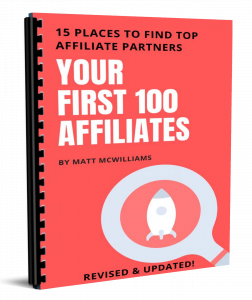 |
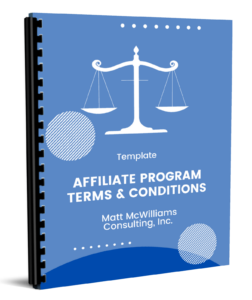 |
 |
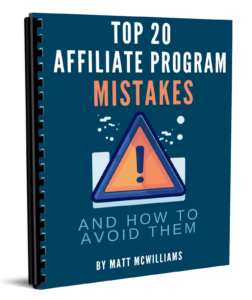 |
 |
 |
 |
 |
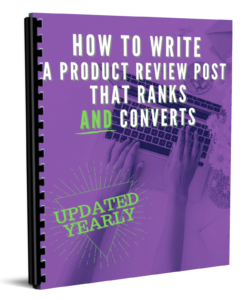 |



